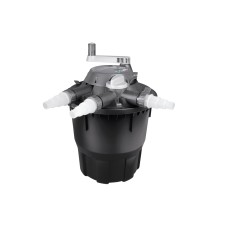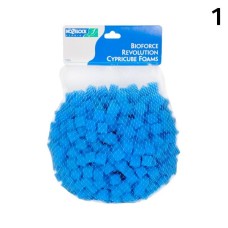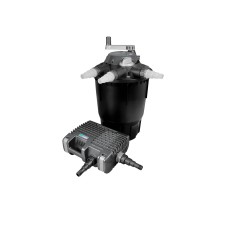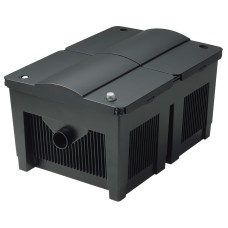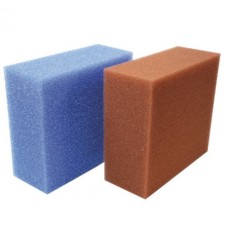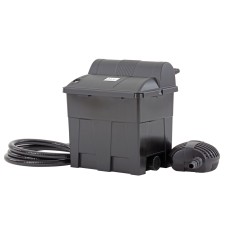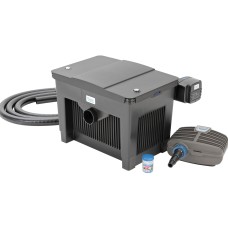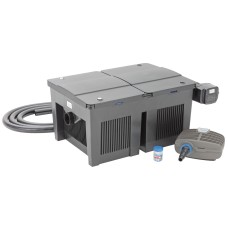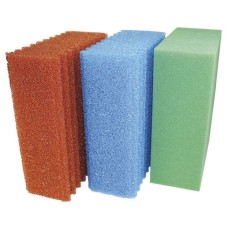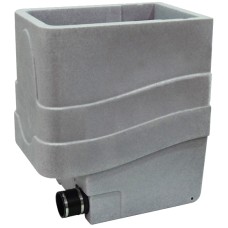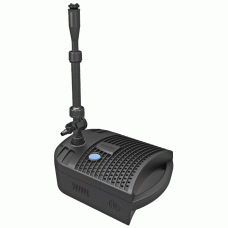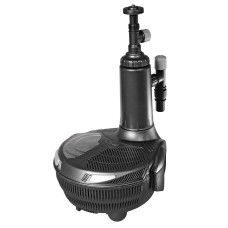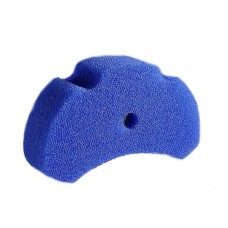Pond Filters
Filters for Koi or Garden Ponds. The main use of filters on ponds, is for biological filtration. There are three main types of filtration: Biological, Mechanical and Chemical. Biological Filtration is the breakdown of toxic fish waste by living organisms to produce less toxic end products. Generally, friendly bacteria (e.g. Nitrosomas and Nitrobacteria spp.) breakdown Ammonia (which can be toxic) through Nitrite (also toxic) to NItrate (only toxic in very high levels). Partial water changes and, or de-nitrating filters (e.g. vegetable filters) are then used to prevent too high nitrate levels. Mechanical filters are designed to remove particulates; for example sediment, leaves, chelated or larger algae clumps, in the water. Removing particulates prevents them from clouding the water or otherwise being unsightly. Chemical filtration is the use of chemicals, for example Carbon or Phosphate remover, to remove chemicals or substances from the water. Usually chemical filters work by binding the unwanted substance to themselves, so that when the chemical filtration media is removed, so is the unwanted substance. Some chemical media are rechargeable, some are simply discarded once they have extracted as much as they can.
Refine Search
Bioforce Revolution
The ultimate no fuss cleaning system.The Bioforce Revolution is an advanced pressurised filter with ..
From: £279.95 Ex Tax: £233.29
Bioforce Revolution Foam Cubes
Replacement Foam cubes for all models in the Bioforce Revolution Range.The Bioforce Revolution 6000 ..
From: £36.99 Ex Tax: £30.83
Bioforce Revolution Kit
Combining the convenience of the Bioforce Revolution pressurised filter with a powerful an..
From: £395.90 Ex Tax: £329.92
BioSmart 36000
Reliable and flexible implementation – entry-level flow-through filterEasy maintenance thanks to cle..
From: £427.49 Ex Tax: £356.24
BioSmart 7000 Replacement foam
BioSmart 7000 Replacement FoamsRed Foam - 35791Blue Foam - 35792..
From: £19.19 Ex Tax: £15.99
BioSmart Set 14000
Reliable and flexible implementation – entry-level flow-through filterEasy maintenance thanks to cle..
From: £293.99 Ex Tax: £244.99
BioSmart Set 18000
Reliable and flexible implementation – entry-level flow-through filterEasy maintenance thanks to cle..
From: £530.99 Ex Tax: £442.49
BioSmart Set 24000
Reliable and flexible implementation – entry-level flow-through filterEasy maintenance thanks to cle..
From: £629.99 Ex Tax: £524.99
BioSmart Set 36000
Reliable and flexible implementation – entry-level flow-through filterEasy maintenance thanks to cle..
From: £757.49 Ex Tax: £631.24
BioSmart Set 7000
Reliable and flexible implementation – entry-level flow-through filterEasy maintenance thanks to cle..
From: £244.99 Ex Tax: £204.16
BioTec/BioSmart Filter Foams
Replacement Filter Foams.BioTec 5.1 - 10.1BioSmart 18 - 36,000..
From: £20.39 Ex Tax: £16.99
Cetus Sieve
Pre-filter to remove waste & debris The Cetus sieve is a bow screen pre-filter, made using the l..
From: £745.00 Ex Tax: £620.83
Combi Clear
The one-plug solution for small ponds.4-in-1 underwater filter with pump,UVC, filter media and fount..
From: £99.99 Ex Tax: £83.33
Easy clear
EasyClearThe award winning all-in-one pond solution.Key Benefits Include:All-in-one unit that combin..
From: £119.75 Ex Tax: £99.79
EasyClear Filter Foams
Replacement Hozelock filter foams for all the EasyClear range.This filter foam is suitable for..
From: £9.99 Ex Tax: £8.33


